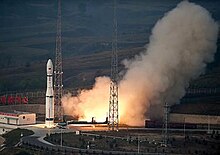38°50′57″N 111°36′29″E / 38.8491°N 111.608°E
 Long March 6 on Launch Pad 16 | |||||||||||||||||||||||||||||||||||||||||||||||||
 | |||||||||||||||||||||||||||||||||||||||||||||||||
| Location | Kelan, Xinzhou, Shanxi | ||||||||||||||||||||||||||||||||||||||||||||||||
|---|---|---|---|---|---|---|---|---|---|---|---|---|---|---|---|---|---|---|---|---|---|---|---|---|---|---|---|---|---|---|---|---|---|---|---|---|---|---|---|---|---|---|---|---|---|---|---|---|---|
| Coordinates | 38°50′56.71″N 111°36′30.59″E / 38.8490861°N 111.6084972°E | ||||||||||||||||||||||||||||||||||||||||||||||||
| Short name | TSLC | ||||||||||||||||||||||||||||||||||||||||||||||||
| Operator | CASC | ||||||||||||||||||||||||||||||||||||||||||||||||
| Total launches | 121[a] | ||||||||||||||||||||||||||||||||||||||||||||||||
| Launch pad(s) | Four (Three active and One Retired) | ||||||||||||||||||||||||||||||||||||||||||||||||
| Launch history | |||||||||||||||||||||||||||||||||||||||||||||||||
| Status | Active | ||||||||||||||||||||||||||||||||||||||||||||||||
| |||||||||||||||||||||||||||||||||||||||||||||||||
The Taiyuan Satellite Launch Center (TSLC)[1] also known as Base 25 (Chinese: 二十五基地), is a People's Republic of China space and defense launch facility (spaceport). It is situated in Kelan County, Xinzhou, Shanxi Province and is the second of four launch sites having been founded in March 1966 and coming into full operation in 1968.
The facility was built as part of China's Third Front campaign to develop basic industry and national security in China's rugged interior in case of invasion by the Soviet Union or the United States.[2]
Taiyuan sits at an altitude of 1500 meters and its dry climate makes it an ideal launch site. The site is primarily used to launch meteorological satellites, Earth resource satellites and scientific satellites on Long March launch vehicles into Sun-synchronous orbits. TSLC is also a major launch site for intercontinental ballistic missiles and overland submarine-launched ballistic missile (SLBM) tests.
The site has a sophisticated Technical Center and Mission Command and Control Center. It is served by two feeder railways that connect with the Ningwu–Kelan railway.[1]
Launch pads edit
- Launch Site 7: CZ-1D, CZ-2C/SD, CZ-4A, CZ-4B and CZ-4C vehicles.[3][4] Entered operations in 1979 and was remodeled in 2008.[5] Located at 38°50′55″N 111°36′29″E / 38.848737°N 111.607970°E.
- Launch Site 9: CZ-2C, CZ-2D, CZ-4B and CZ-4C.[6] First use on 25 October 2008.[7][5] Located at 38°51′48″N 111°35′23″E / 38.863200°N 111.589639°E.
- Launch Site 16: CZ-6 and Kuaizhou-1A.[8] The CZ-6 Launch Pad was completed in 2014.[5] Located at 38°52′06″N 111°34′49″E / 38.868223°N 111.580264°E.
- Launch Site 9A: CZ-6A. Located at 38°51′31″N 111°35′05″E / 38.858654°N 111.584808°E.
Recent launches edit
This article needs to be updated. (September 2020) |
| Date | Vehicle | Payload | Outcome | Notes |
|---|---|---|---|---|
| 6 November 2020 03:19 UTC | Long March 6 | 10 ÑuSat 9-18 | Success[9] | |
| 29 March 2022 09:50 UTC[10] | Long March 6A | Pujiang-2
Tiankun-2 |
Success[11] | First flight at the "smart" launch pad, and the maiden flight of Long March 6A. |
Taiyuan Satellite Launch Center was to launch a satellite coded as the 03 Group of the Shijian-6 serial research satellites sometime on 24 October 2008. The rocket carrier was to be a Long March 4B, said the official, noting both the satellite and the rocket were in good condition and all the preparations for the launch had been completed.[12]
The DongFang Spaceport edit
The DongFang Spaceport (东方航天港) is a maritime launch center under the jurisdiction of Taiyuan Satellite Launch Center.[13] Its home port is in Haiyang, Yantai.[14] It uses sea launch platforms to perform launch missions in the exclusive economic zone outside China's territorial waters or in coastal waters. It can accept launch missions from private commercial rockets.
The first launch mission was serial number HY1 mission of Long March 11 on 04:06, 5 June 2019, which was successful in the Yellow Sea.[15] The recent launch was the first launch of Gravity-1 on 13:30, 11 January 2024, which was successful in the Yellow Sea.[16]
See also edit
References edit
- ^ In addition to the flights that took place in the mentioned launch pads, two Kuaizhou-1A launches that took place in an unidentified location within the launch complex are included in the count.
- ^ a b "Taiyuan". www.astronautix.com. Retrieved 27 June 2023.
- ^ Meyskens, Covell F. (2020). Mao's Third Front: The Militarization of Cold War China. Cambridge, United Kingdom: Cambridge University Press. pp. 4, 218. doi:10.1017/9781108784788. ISBN 978-1-108-78478-8. OCLC 1145096137. S2CID 218936313.
- ^ "太原卫星发射中心从卫星影像看发射塔". 中国象山同乡网. 30 October 2007. Retrieved 9 June 2008. [dead link]
- ^ "Taiyuan LC1". www.astronautix.com. Retrieved 27 June 2023.
- ^ a b c "Taiyuan Satellite Launch Centre". China Space Report. 27 May 2016. Retrieved 27 June 2023.
- ^ "Taiyuan LC9". www.astronautix.com. Retrieved 27 June 2023.
- ^ 太原卫星发射中心启用新工位 航天发射能力跃升 (in Chinese). China News. 25 October 2008. Retrieved 27 October 2008.
- ^ "Taiyuan LC16". www.astronautix.com. Retrieved 27 June 2023.
- ^ "China launches two natural disaster monitoring satellites". Xinhua. 6 September 2008. Archived from the original on 6 September 2008.
- ^ Beil, Adrian (29 March 2022). "China debuts Chang Zheng 6A, teases more variants". NASASpaceFlight.com. Retrieved 30 March 2022.
- ^ "China launches first Long March rocket with solid boosters". SpaceNews. 29 March 2022. Retrieved 31 March 2022.
- ^ "China to launch satellite on Saturday_English_Xinhua". Archived from the original on 21 October 2012. Retrieved 24 October 2008.
- ^ "我国首次海上远距离机动发射 捷龙三号运载火箭有哪些新突破?".
- ^ ""中国东方航天港"项目计划年内启动实施,力争在海阳打造我国首个海上发射母港,副标题:推动海上发射高频化常态化系统化". 海阳市人民政府. 23 July 2019. Archived from the original on 31 March 2022. Retrieved 17 September 2020.
- ^ Barbosa, Rui C. (5 June 2019). "China conducts first Sea Launch mission with Long March 11 launch of seven satellites". NASASpaceflight.com. Retrieved 5 June 2019.
- ^ Jones, Andrew (11 January 2024). "Orienspace breaks Chinese commercial launch records with Gravity-1 solid rocket". SpaceNews. Retrieved 11 January 2024.